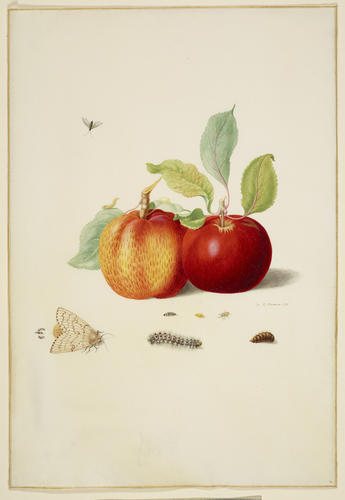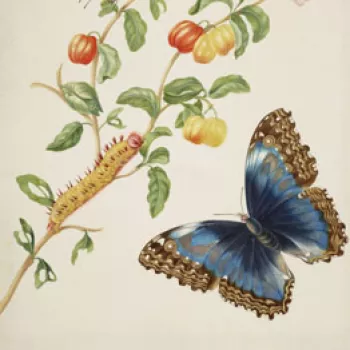Two Apples with Gypsy Moth c.1705?
Watercolour and bodycolour with gum arabic on vellum | 40.2 x 27.5 cm (vellum sheet) | RCIN 921230
-
A watercolour of two Apples with the life cycle of the Gypsy Moth (Lymantria dispar dispar) and other insects. The depiction of the moth, caterpillar and chrysalis are taken from Merian's book on caterpillars (Der Raupen Wunderbare Verwandelung, 1679), where they are shown on apple blossom (volume I, plate 18). This is probably a later work based on the plate in the book. The drawing is signed by the artist at bottom right: 'M.S. Merian fec[it]'. An unidentified collector's inscription on the verso is visible through the vellum at bottom centre.
Maria Sibylla Merian was the daughter of the printmaker Matthias Merian, and the step-daughter of the still-life painter Jacob Marrel. She was a talented artist, who was trained in flower painting by Marrel. From an early age, she was fascinated by insects and their life cycles, and undertook research into the phenomenon of metamorphosis, which was then only partially understood. She published her findings in a series of books, illustrated with beautifully-composed plates in which each insect life-cycle was illustrated on the appropriate food plant. In 1699, having encountered exotic insects in the cabinets of natural history collectors in Amsterdam, Merian and her younger daughter Dorothea set sail for Suriname, in South America, which was then a Dutch colony. There, they studied the life cycles of Surinamese insects until their return to Europe in 1701. Merian published her Surinamese research as the Metamorphosis Insectorum Surinamensium (The Metamorphosis of the Insects of Suriname) in 1705. The book was very well-received, and by her death Merian was well-regarded throughout Europe as both an entomologist and an artist.Provenance
Dr Richard Mead (1673–1754); his sale (London, Abraham Langford, 13–16 January 1755, lot 66), where purchased by an unknown collector; sold 15 June 1768 (London, Paterson and Eve, lot 572), where purchased by Sir John Hill via Wilson; George III by c.1810
-
Creator(s)
Acquirer(s)
-
Medium and techniques
Watercolour and bodycolour with gum arabic on vellum
Measurements
40.2 x 27.5 cm (vellum sheet)
Other number(s)
RL 21230









